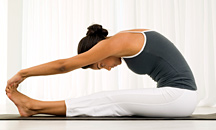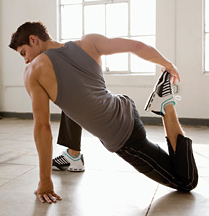Take Time to Stretch
By Chelsea Cooper
Let's face it, most people do not enjoy stretching. If you think about it, it's probably close to the bottom of your list of priorities when you work out or do any other type of physical activity. In fact, stretching is probably the most overlooked aspect of physical fitness, and yet it is one of the most important. I continually stress the benefits of stretching to my clients, and the ones who take my advice see a difference in their workouts and everyday lives. By the end of this article, you will have the information and the tools to put together a great stretching program, too.
Why We Need to Stretch
 As we age, our muscles tighten and range of motion in our joints decreases. This can impact even the most active lifestyle and hinder your normal day-to-day activities. Tasks that used to be simple, like zipping up a dress or reaching for a can off the top shelf, may become extremely difficult. A regular stretching program can help lengthen your muscles and make daily activities routine again.
As we age, our muscles tighten and range of motion in our joints decreases. This can impact even the most active lifestyle and hinder your normal day-to-day activities. Tasks that used to be simple, like zipping up a dress or reaching for a can off the top shelf, may become extremely difficult. A regular stretching program can help lengthen your muscles and make daily activities routine again.
The word flexible comes from the Latin word flexus, which means "to bend." Flexibility is the degree to which an individual muscle will lengthen. Stretching increases flexibility, which will help you perform daily activities and reduce the risk of muscle, joint and tendon injuries. Stretching also improves circulation, increasing blood flow to the muscles. Increased blood flow provides more nourishment to the muscles and gets rid of more waste by-products in the muscle tissue itself. Improved circulation can also help speed up recovery time if you suffer a muscle injury.
What's more, stretching can help eliminate or decrease low back pain, one of the most common kinds of structural pain, affecting a large percentage of the population. Muscle tightness in the quadriceps, hamstrings, hip flexors, and low back muscles is a common cause of low back pain. Stretching these muscles will often eliminate the pain. Keep in mind that every joint is tied to another joint, so if one muscle is tight, it is going to affect another joint or muscle.
 One of the greatest benefits of stretching is that you're able to increase your range of motion, which means your joints can move further before an injury occurs. Stretching after you exercise (at least after you've warmed up a bit) has proven to be much more effective than pre-workout stretches, because by the time you've completed your workout, the muscles are "warm." Post-exercise stretching also helps reduce soreness, improves workout recovery, and ensures muscle and tendons are working properly.
One of the greatest benefits of stretching is that you're able to increase your range of motion, which means your joints can move further before an injury occurs. Stretching after you exercise (at least after you've warmed up a bit) has proven to be much more effective than pre-workout stretches, because by the time you've completed your workout, the muscles are "warm." Post-exercise stretching also helps reduce soreness, improves workout recovery, and ensures muscle and tendons are working properly.
Different Ways to Stretch
There are three main types of stretching/flexibility programs: static (corrective) stretching, active stretching and functional stretching. No matter what type of flexibility program you are on, in the end it will help with posture, relieve muscle tightness and imbalances, prevent injury and improve the quality of everyday activities we take for granted from time to time.

